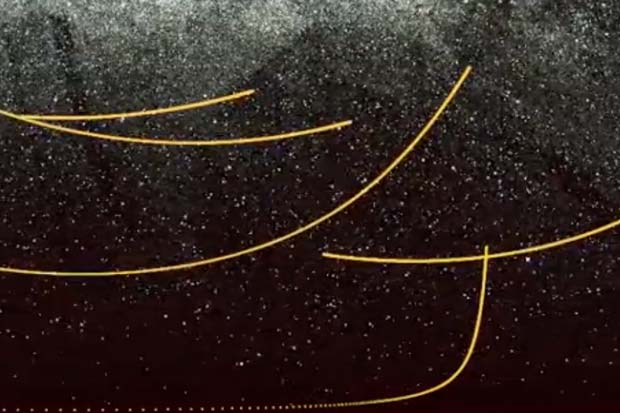Catch a Speeding Star: High-Velocity Milky Way Objects Tracked (Animation)
A new animated video from the European Space Agency shows how the stars in Earth's galaxy have moved over the last million plus years — and tracks the movement of six special stars that are speeding through the Milky Way.
Researchers pulled the animated data from one of the first waves of information to come from Gaia, an ESA satellite on a mission to chart a 3D map of the Milky Way.
The stars in the video start at the positions they were in about 1,035,000 years ago, according to the description on the video. The animation follows the stars over the years, ending on their position when Gaia collected data between 2014 and 2015. [How the Gaia Galaxy-Mapping Satellite Works (Infographic)]

The six stars trailed by yellow lines are hypervelocity stars, which means that they move at hundreds of kilometers per second (which is hundreds of thousands of miles per hour). These stars are moving much faster than most stars in the galaxy, and were likely accelerated by interacting with the supermassive black hole at the center of the Milky Way, a statement from the ESA said.
"These hypervelocity stars are extremely important to study the overall structure of our Milky Way," Elena Maria Rossi a professor at Leiden University in the Netherlands, who presented Gaia's discovery of these six stars at the European Week of Astronomy and Space Science in June, said in the statement.
Scientists can use the trajectory of these stars to characterize the gravitational field of the galaxy, from its center to the outer edges, as well as the possible effects of dark matter. One star, labeled No. 1 in the video, is moving so fast — more than 500 km/s or more than 1 billion mph — that the ESA thinks the object might someday break through the gravitational field and leave the galaxy.
Get the Space.com Newsletter
Breaking space news, the latest updates on rocket launches, skywatching events and more!
But the slower five stars are even more interesting to scientists, the statement said: They are still bound to the Milky Way's gravity, and dark matter may have played a role in slowing them down, the researchers said.
Space.com senior producer Steve Spaleta contributed to this report.
Follow Kasandra Brabaw on Twitter @KassieBrabaw. Follow us @Spacedotcom, Facebook and Google+. Original article on Space.com.
Join our Space Forums to keep talking space on the latest missions, night sky and more! And if you have a news tip, correction or comment, let us know at: community@space.com.

Kasandra Brabaw is a freelance science writer who covers space, health, and psychology. She's been writing for Space.com since 2014, covering NASA events, sci-fi entertainment, and space news. In addition to Space.com, Kasandra has written for Prevention, Women's Health, SELF, and other health publications. She has also worked with academics to edit books written for popular audiences.









